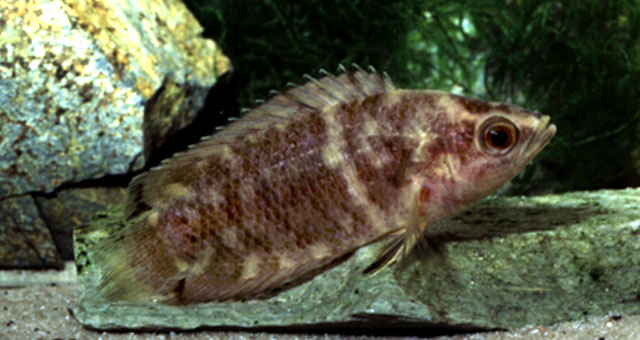|
Dorsal spines (total): 16-18; Dorsal soft rays (total): 8-10; Anal spines: 9-10; Anal soft rays: 9-11; Vertebrae: 26. Diagnosis: snout blunt; jaws weakly protrusible (ascending process of premaxilla short, not reaching anterior border of orbit)(Ref. 57414). Pelvic fins darkly pigmented; labyrinth simple, composed of single unfolded plate; body and head dark brown, flanks sometimes mottled (Ref. 57414, 81650, 93191). Caudal spot present; 16-18 (mode 17) pored scales in upper lateral line (Ref. 57414, 81650, 93191), 9-12 in lower (Ref. 93191). 10-16 scales on right operculum; scales in vertical series 3.5-4.5/8-9; interorbit into head length 3.2-3.7 (Ref. 93191).
Description: labyrinth organ substantially reduced in size and complexity compared to other Ctenopoma (Ref. 57414, 81650), composed of a simple plate extending medially into suprabranchial chamber and lacking any augmentation (Ref. 81650). 1 cephalic pore in interocular space (Ref. 57414). 16-19 scales in upper lateral line; 9-12 scales in lower lateral line; 3-4 scales above anterior end of upper lateral line, 3.5-4.5 above posterior end of upper lateral line, 8-9 below upper lateral line (Ref. 57414, 81650). Operculum serrated, suboperculum sometimes serrated (Ref. 57414). Interoperculum and preoperculum rarely serrated (Ref. 57414, 81650). 16 soft rays in caudal fin (Ref. 57414). 2-5 serrations above opercular notch, none within notch, 2-4 serrations below, 0-19 subopercular serrations; caudal peduncle contact organs absent or very faintly developed (in available specimens)(Ref. 81650).
Coloration: ground colour dark chocolate brown, often broken by light brown mottling on flank and head; ground colour extends onto unpaired fins, which usually have transparent distal borders; pelvic fins always darkly pigmented; belly and throat light tan often with dark mottling and/or crossed by several irregular dark bars; underside of mandible at snout with a dark brown bar; some specimens with a narrow, pale vertical bar extending from base of dorsal fin to just posterior of pelvic fin base, and streaks of dark pigment posterior to eye or at angle of jaw (Ref. 57414, 81650). Young specimens (36 mm SL) overall darkly pigmented, with random light flecks on flank, and transparent borders to unpaired fins (Ref. 57414). |
